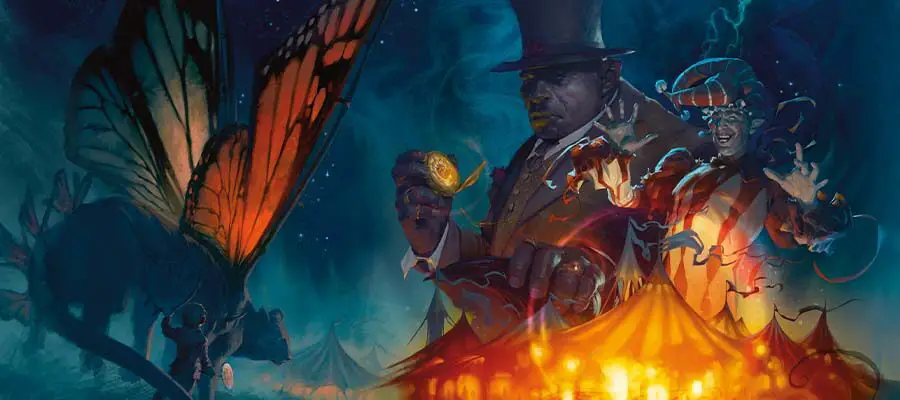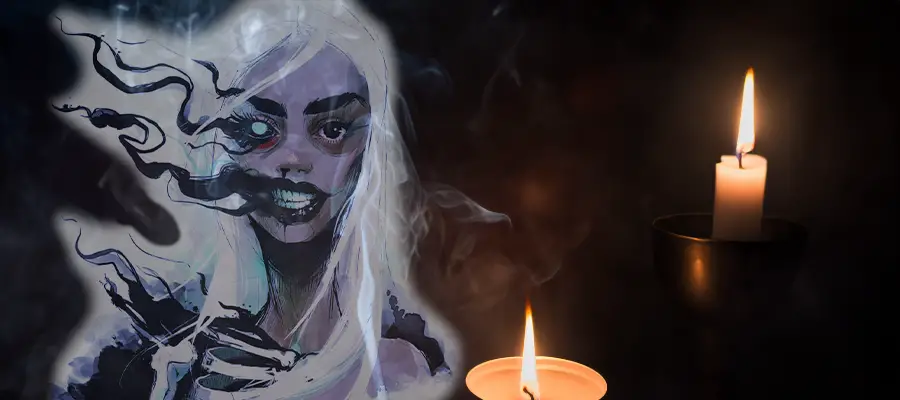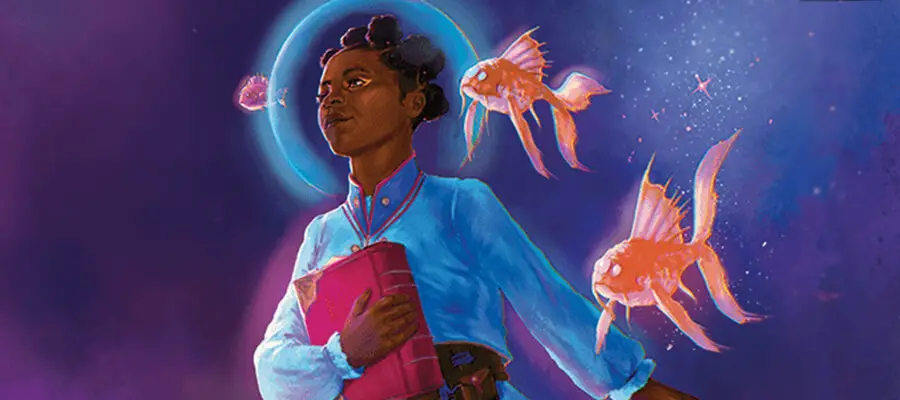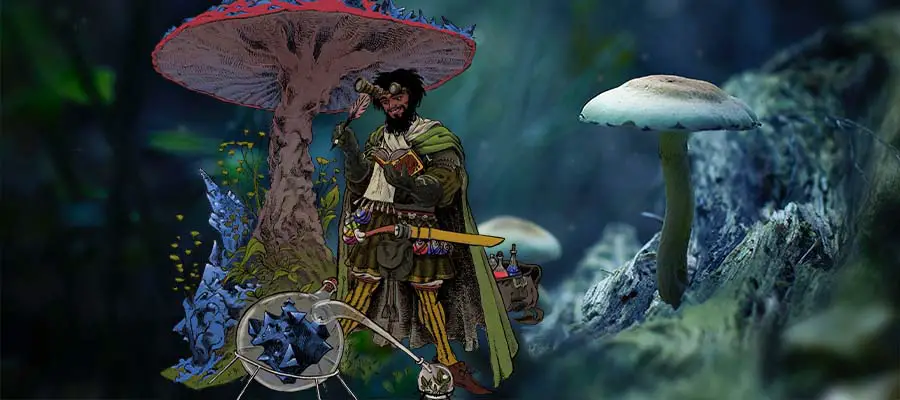Wild Beyond the Witchlight review featured image is credited to Wizards of the Coast’s D&D 5e The Wild Beyond the Witchlight: a Feywild Adventure.
Disclaimer: This article contains affiliate links that add gold to our coffers.
The Wild Beyond the Witchlight was advertised as D&D 5e’s first “non-violent” campaign, as well as the first 5e material to formally venture into the Feywild. But between its fantastical flavor, cultural resonance, and DM-friendly structure, it may be 5e’s best official campaign thus far.
Why? Let’s dive right in.
The Good
Let’s start with the basics. The Wild Beyond the Witchlight is 5e’s first foray into the Feywild, a mystical land of vivid sensations, whimsical caricatures, and fantastical adventures. In contrast to the dark and dreary Shadowfell showcased in Curse of Strahd and Van Richten’s Guide to Ravenloft, Witchlight introduces a stunning fusion of classic folk tales, fairy tales, and children’s literature that lives up to its name as the first introduction of the “Demiplanes of Delight.”
“Resonance” is a core element of game design, and Witchlight fulfills it with aplomb. A game resonates with its players when it builds on top of information that its audience is already familiar with—and every inch of Witchlight’s creative space leverages beloved fairy tale tropes and folk tale fantasies to build a unique Dungeons & Dragons experience.
It’s got rabbitfolk brigands with magical scarves. Tea-parties of talking animals. Plates of gingerbread elves lying in the wilderness. Evil hags with unique weaknesses for clever heroes to exploit. A village filled with chivalrous, froglike bullywugs whose affinity for inane politicking feels a half-step removed from Lewis Carrol’s Alice in Wonderland. If you can think of a fairy-tale trope, odds are good that Witchlight pays it homage at least once.
The campaign builds on top of these familiar elements with strong narrative and worldbuilding themes. In dealing with Fey enemies and allies, the players must grow familiar with the unique rules and customs that dictate this strange, alien realm, such as the Rule of Hospitality, the Rule of Ownership, and the Rule of Reciprocity. Moreover, the world responds to everyday events with a unique fey color: an outburst of happiness might conjure a chorus of birdsong or the blooming of flowers, while an outpouring of anger may summon a rotten stench on the wind, a frowning cloud, or the sprouting of ugly, thorny weeds.
The campaign’s vivid Feywild flair is further accentuated by its colorful cast of delightful characters. Whether it’s Sir Talavar, the gallar faerie dragon knight; Agdon Longscarf, the boastful, sticky-fingered rabbitfolk brigand; or Lamorna, the mystical, mournful unicorn, the vast majority of Witchlight’s NPCs will leave your players simultaneously amused and bemused for a long time to come.
When it comes to the nuts-and-bolts of the campaign, Witchlight is also a welcome step forward for DMs struggling to find a campaign that’s easy to run out-of-the-box. Most D&D campaigns have severe structural problems. Descent Into Avernus begins with an undercooked, unrelated prologue and focuses more on a sidekick’s story than the PCs. Curse of Strahd is a rich sandbox, but extraordinarily disorganized. Storm King’s Thunder throws DMs into the deep end, expecting them to spend far more time homebrewing missing content than actually running the adventure.
Not so with The Wild Beyond the Witchlight. With two glaring exceptions—which we’ll get to later—this campaign is tightly plotted, evocatively written, and flexible enough to allow room for a DM’s creativity to flourish. Unlike Avernus, Witchlight’s sizable Chapter 1 (the eponymous Witchlight Carnival) contains a cast of colorful characters, scenarios that highlight player agency and creativity, and several opportunities for the players’ early decisions to reverberate later on in the adventure.
Moreover, the campaign makes use of a robust “flexi-linear” structure, simultaneously allowing players to roam free within a trio of carefully sequenced miniature sandboxes (the three regions of Prismeer: Hither, Thither, and Yon), while still encouraging DM control through well-tailored plot hooks and a controlled flow of information. Like The Witcher III: The Wild Hunt, while the characters are technically free to explore any of the three regions, Witchlight provides clear direction and momentum from one objective to the next. More importantly, unlike Avernus, these sequential sidequests never quite overstay their welcome, lingering just long enough to create a memorable set piece without ever forcing the PCs to retrace their steps.
Critically, Witchlight has the courage to offer what Icewind Dale, Tomb of Annihilation, and most other 5e campaigns failed to: an optional hook that gives the characters a direct and personal motivation to complete the campaign. While its “Warlock’s Quest” story hook kicks things off with a more traditional NPC questline, Witchlight’s “Lost Things” story hook presents the campaign’s villains as the players’ personal antagonists: Years ago, the minions of the Hourglass Coven stole something precious from the characters as children. Now, it’s up to the characters to find their way back to the Witchlight Carnival and locate a path to the Feywild to reclaim what once was taken.
While Witchlight takes full advantage of its relatively linear narrative, the campaign itself has several rich opportunities for divergent storytelling. For example, the characters are free to deal with the hags of the Witchlight Coven as they see fit—through trickery, negotiation, or, if they’re brave enough, outright violence—and many hostile encounters can be approached as puzzles, conversations, or combat encounters, depending on the characters’ preferred strategies and tools.
This “linear story, sandbox storytelling” approach is further strengthened by each region’s random encounter tables. Unlike Curse of Strahd or Rime of the Frostmaiden, each of Witchlight’s twenty-four random encounters present clear opportunities to grow the flavor, world, and story of the campaign. Bursting bubbles of marsh gas may give a player hiccups for the next hour of travel. Hobgoblins foraging on stilts can provide an eerie, but intriguing opportunity to share information. There are opportunities for combat if the DM wishes, of course, but Witchlight highlights an important principle that DMs should remember: random encounters may be random, but they should not feel random.
Witchlight also provides an intriguing DM tool in its appendix: its four-page “Story Tracker,” which offers areas to log the characters’ histories, their escapades in Prismeer, and additional notes and reminders. Certain sections of the module will explicitly direct the DM to note down particular events, characters, or effects that may later prove relevant. For new DMs unsure how and when to track information in long-term campaigns, it’s sure to be a helpful resource. For more experienced DMs, while Witchlight’s Story Tracker is not quite ambitious enough to be meaningful, it’s a laudable step forward given Wizards’ historic reluctance to provide logistical DMing tools.
The Bad
That’s not to say that The Wild Beyond the Witchlight is a perfect campaign, of course. As in Curse of Strahd, Wizards of the Coast seems almost comically terrified of illustrating or even predicting the outcomes of any potential encounters with the Hourglass Coven. Instead, DMs are presented with a pile of puzzle pieces—the players’ motivations, the hags’ dispositions, and the three dungeons the members of the Coven call home—and asked to forge a trio of climactic showdowns without further guidance.
Second, as in all 5e campaigns, Witchlight is presented more as a storybook than a reference book. DMs hoping to read and run this campaign chapter-by-chapter will once again be disappointed, with the core events of Prismeer’s recent history—including the imprisonment (and true identity) of the archfey Zybilna, the rise of the Hourglass Coven, and the history of NPC adventuring parties Valor’s Call and the League of Malevolence—scattered across multiple chapters and character bios. As such, DMs must once again read the entire book once (or twice!) through in order to fully understand how everything in the Domain fits together. While this is a likely concession to the fact that a majority of Wizards’ customers prefer to read modules, not play them, it would do little harm for Witchlight to include a comprehensive, one-page history in its introduction to get DMs quickly up-to-speed
The aforementioned NPC adventuring parties, Valor’s Call and the League of Malevolence, present a different, thornier issue. While these Arthurian forces for Good and Evil certainly fit Witchlight’s mold of folktale storytelling, their straightforward fantasy tropes tend to clash with the whimsical, Alice-in-Wonderland elements that round out the rest of Prismeer. Some playgroups may not mind their grounding presence. However, for parties looking to immerse themselves in Witchlight’s fairy-tale thematics, this sudden right turn into an episode of Merlin may prove jarring.
Other reviews have criticized the story’s use of the “lost unicorn horn,” a missing MacGuffin whose location is randomized and whose discovery is largely a crapshoot. While Witchlight should be faulted for its failure to properly point characters in the right direction, the case against the unicorn horn is largely overstated. The horn itself is necessary only to obtain the “best ending,” in which the PCs receive a free Wish spell. The campaign’s “good ending” is freely accessible even without the horn, and while it may not quite include a Wish, the epilogue is unlikely to disappoint.
Conclusions
The Wild Beyond the Witchlight, despite minor flaws, is arguably 5e’s best campaign to date. Between a setting that oozes flavor and theme, a character-driven storyline with color and panache, and a campaign structure that even veteran DMs can learn from, Witchlight is 5e’s first slam-dunk campaign since Curse of Strahd. After years of waiting, the Feywild has finally arrived to 5th Edition—and it’s likely to make a splash.
The Wild Beyond the Witchlight can be purchased from your local game store, through online retailers, or through Wizards of the Coast’s digital partners. Click here to learn more, or click here to purchase your copy.
About the Author: DragnaCarta is a guest writer for FlutesLoot.com and a veteran DM with 12+ years of experience. He is the author of the popular “Curse of Strahd: Reloaded” campaign guide, a moderator of /r/CurseOfStrahd, and the Dungeon Master and director for the Curse of Strahd livestream “Twice Bitten.” You can get his D&D hot takes and commentary by following his Twitter, or get personal RPG mentoring plus early access to projects by joining his Patreon.
Cast Message in the comments section below to ask DragnaCarta about this topic. You can find other articles by DragnaCarta on FlutesLoot.com.




